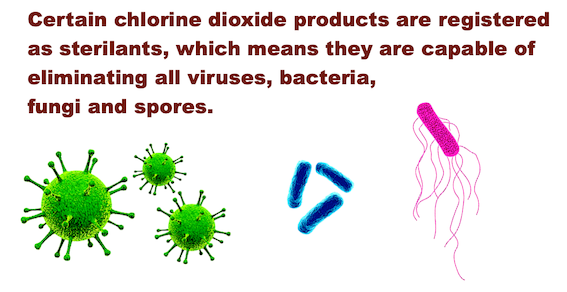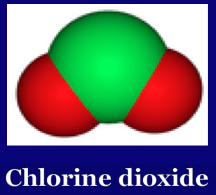“A Norwegian study of 141,000 births over three years found
a 14 per cent increased risk of birth defects
in areas with chlorinated water.

Chlorine dioxide is less corrosive than chlorine and
superior for the control of legionella bacteria.
Cancer-Causing Atrazine Is World’s
No. 1 Drinking Water Contaminant
Learn more
http://www.naturalnews.com/044776_atrazine_drinking_water_contaminant_carcinogens.html#ixzz4UeuR4bNe
ATRAZINE AND CHLORINE
Over the last 30 years, a growing body of research has shown the assorted
disinfection by-products of chlorine (DBP’s) are very harmful to your
health, however organisations like the Chlorine Institute and the
Chemical Manufacturers Association have a serious and
well-funded interest in maintaining the status quo.
http://www.mercola.com/Downloads/bonus/chlorine/default.aspx
Chlorinated Water Yields 14% Increase In, Still Births And Birth Defects
By Jacqui Thornton and Martyn Halle – The UK Telegraph
An independent study into the use of chlorine-treated drinking water has been ordered by the Government because of fears that it may cause spina bifida and stillbirths.
Please note ⇒ chlorine dioxide ClO2. is safer than chlorine

[ Dr Greg Simpson → Management of Biofilm ] ←
See also our site on ⇒ Coral Bleaching
Scientists from Imperial College, London University, will carry out the research after doctors in Norway, Canada and the United States reported higher levels of birth defects in areas where chlorine is used, compared with drinking water treated by alternative methods. All of Britain’s water companies chlorinate their supplies. The only people who have non-chlorinated water are those with their own bore holes or wells.
A Norwegian study of 141,000 births over three years found a 14 per cent increased risk of birth defects in areas with chlorinated water. Scientists have already found an association between chlorine and an increased risk of bowel, kidney and bladder cancer, but it is the first time that a link has been found with higher levels of spina bifida. Last night the Spina Bifida and Hydrocephalus Association said it was “concerned” by the findings and would be discussing them with medical advisers before considering making representations to the Government. British water industry experts have not dismissed the findings but said that the safety benefits of purification outweigh the risks of birth defects. Dr Per Magnus, who carried out the Norwegian research, said: “This is an important finding because we know there are chemicals released by the action of chlorine on organic particles at treatment works.
We have observed mutations in these chemicals which seem to tie up with mutations that are found in babies. We were in a unique position in Norway to make these observations because in some areas our water comes from the mountains and doesn’t require cleaning with chlorine.” The Norwegian government has ordered more research. Concerned families there have been filtering tap water. A popular method has been to place sachets of coral sand, dredged from fjords, into water before it is drunk, removing all traces of chlorine in tap water in 15 minutes. In Canada, at Dalhousie University, Nova Scotia, researchers found that high levels of trihalomethanes, a by-product of chlorine in drinking water, significantly increased the risk of stillbirth. Dr John Marshall, of the Pure Water Association, a pressure group which has been campaigning for safer drinking water, said: “It shows we should be paying more attention to the chemicals we put in drinking water and be looking for other alternatives to chlorination. A number of safe, non-toxic options exist, such as treating water with the gas ozone or ultra violet.” Chlorine is in the same chemical group as fluoride, which has been linked with cancer and osteoporosis. There is also a connection between fluoride and increased blood pressure and an increase in problems with the thyroid gland. John Fawell, a leading specialist on water quality, and an independent industry consultant, said the British Government and water companies were taking the danger of birth defects seriously. He said: “The people who have done this work in Norway and the United States are reputable researchers and the Government and water companies have commissioned their own research from London University. “But at present the conclusion of the World Health Organisation and other concerned bodies is that the risk from contaminated water supplies outweighs the risk to health from chlorine. Levels of chlorine and its by-products have been falling in water and the amount coming out of the average tap is half a millilitre per litre.” 6 February 2000: [UK News] Parents told to sue for school drinking water 17 January 1999: [UK News]
By Jacqui Thornton and Martyn Halle – The UK Telegraph
INACTIVATION EFFECT OF CHLORINE DIOXIDE ON
PHYTOPATHOGENIC BACTERIA IN IRRIGATION WATER
Kuo-Shan Yao1, Yung-Hsu Hsieh2, Yu-Jie Chang3,
Chen-Yu Chang4,* Ta-Chih Cheng5 and Hui-Lin Liao4
Taiwan 2 Department of Environmental Engineering National
Chung-Hsing University Taichung 402, Taiwan.
⇒ jeeam20-3_157-160 ⇐


Credit: NaturalNews
For more than a half-century, North American farmers have been spraying atrazine, an herbicide, on their crops — most notably corn — in the millions of pounds per year.
This widespread use of the weed killer has also created no small amount of runoff, ensuring that atrazine winds up in lakes, streams and, on occasion, even drinking water, according to a recent report by Global News.
“Atrazine is the number one contaminant found in drinking water in the U.S. and probably globally[,] probably in the world,” University of California-Berkeley scientist Tyrone Hayes told the news organization.
The prevalence of atrazine has, over time, gotten the attention of a number of groups — and some government organizations — regarding its use and, some say, overuse.
One such organization is Health Canada, which confirmed recently that atrazine could indeed make its way into local drinking water. The agency says that, “because atrazine has been classified in Group III (possibly carcinogenic to humans [ Hairy Cell Leukemia ]),” it has set an acceptable amount of 5 parts per billion in drinking water; in the U.S., that level is 3 parts per billion.
But the problem is that atrazine levels in drinking water can vary from place to place, with agricultural regions obviously being more at risk (though not exclusively, as atrazine contained in runoff can travel for hundreds of miles).
‘Most well-studied pesticide on the planet’
“In areas where atrazine is used extensively, it (or its dealkylated metabolites) is one of the most frequently detected pesticides in surface and well water. Atrazine contamination has been reported in British Columbia, Nova Scotia, Prince Edward Island, Quebec, Ontario and Saskatchewan,” said Health Canada.
 The compound is manufactured by Syngenta, the world’s foremost agribusiness giant; the European Union banned atrazine in 2004.
The compound is manufactured by Syngenta, the world’s foremost agribusiness giant; the European Union banned atrazine in 2004.
Nevertheless, research on the compound and its effects has continued, and not just on humans: The effects of atrazine on amphibian and other wildlife are also being studied.
“Atrazine is probably the most well studied pesticide on the planet, perhaps only rivaled by DDT,” University of South Florida Prof. Jason Rohr, told Global News.
There is less information, however, regarding the herbicide’s effects on humans. Some studies have found a potential link between atrazine and ovarian, breast and prostate cancers, as well as birth defects including smaller male genitals and gastroschisis, which is a birth defect in the abdominal wall in which the infant’s intestines can be outside of the belly.
“So for humans there are studies showing a correlation between atrazine exposure and low sperm count or low fertility, increased risk of breast cancer, increased risk of prostate cancer, deformities of the genitals,” Hayes said.
For its part — and perhaps expectedly — Syngenta says such studies suggesting that atrazine is a carcinogen or is otherwise harmful to humans are scientifically flawed;
the company says other experts have reviewed the research and have deemed it unreliable. The company says its herbicide is safe and has been approved for use both by Health Canada and the U.S. Environmental Protection Agency.
Syngenta pays
“Regarding other impacts of atrazine, the EPA stated very clearly in its presentation to the July 2011 Scientific Advisory Panel that the available data do not support any association between atrazine exposure and cancer,” said Ann Bryan, a senior manager for Syngenta, in a statement.
The same panel criticized the EPA for listing all cancers into one category in its atrazine assessment.
“It would be useful and appropriate to make conclusions for individual cancers as opposed to making a blanket determination for cancer in general,” the panel said, adding a list of cancers with “suggestive evidence of carcinogenic potential,” to include ovarian cancer, non-Hodgkin’s lymphoma, hairy cell leukemia and thyroid cancer.
The panel also recommended follow-up studies.
In 2012, as part of a class action lawsuit settlement, Syngenta paid $105 million to more than 1,000 municipal water systems in the U.S. to help pay for the removal of atrazine from drinking water. Syngenta denies any liability.
Sources:


